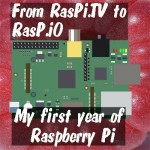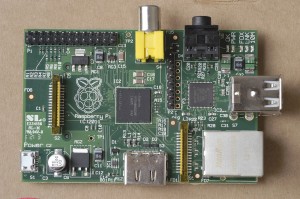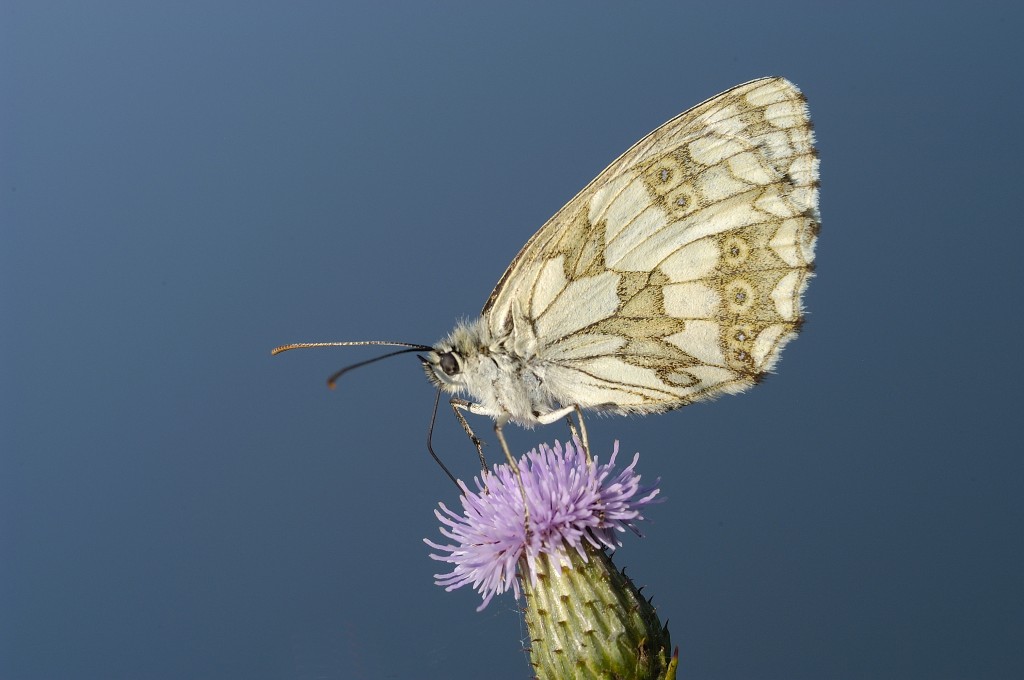
I arose with the larks on 29th February 2012 to participate in the great global DDOS of RS and Farnell’s websites (whilst attempting to order a Raspberry Pi or two). It was with great delight on May 15th that I received my first Raspberry Pi from RS, a week or two after the first lucky 10,000 got theirs after the ethernet port refit.
I had everything ready, including an SD card with the early version of Debian Squeeze on. I’d had months to get it all ready. I connected it all up, using my Galaxy S2 charger as power supply. What can I say? It just worked. :) The GUI was a bit slow, but it worked.
What next?
It’s been an interesting year, full of adventure, discovery and lots of fun. Boy have I learnt a lot as well. I’ve also met some really nice people and made new friends.
On June 1st 2012 I posted my first RasPi.TV blog and in that month I had just shy of 4.5k page views. Since then things have grown “quite a bit.” ;) In April 2013 when hackaday linked to the P6 header reset switch article on their blog, then lifehacker linked it as well the next day, we got nearly double that number in one day. That was exceptional though.
So how did RasPi.TV come about?
I’d been a bit bored of my previous business for some time. After 29th Feb, it was totally obvious to anyone, who wasn’t dead, that the Raspberry Pi was going to be enormous. I felt that as a part-time ICT teacher of 10-year-olds, I needed to be a part of it. It felt, to me, a lot like the internet all over again – a “Wild West” level playing field for all.
The RasPi.TV domain was available and it seemed that it would be a fun idea to to try and become “the Raspberry Pi TV station” and publish some video content. As I found out in class, many people these days want to be shown how to do things rather than reading instructions. Video is perfect for that. Being a writer and having macro photography as a hobby, blogging and stills photography were areas where I had much more experience. Here’s one of my butterfly shots…
But I had shot and cut some videos in the past to share with my online model flying buddies, so it wasn’t a completely scary prospect. (Easystar beach aerial video download link) [I’d like to do some aerial video with a PiCam and a quadcopter this coming year. I just ordered a Pi Camera yesterday at 0546. If that arrives today it will be a perfect start to Pi year 2.] :)
[update – it did come and here’s the ‘quick and dirty’ first day video – more tomorrow]
Linux documentation can be a bit sparse
But before I got around to videos, I noticed that in the Linux world there are lots of very clever people willing to help, (apart from the RTFM crowd) but a lot of the online documentation available is either “a bit lacking in basic detail” or simply out of date. So I figured that every time I do something new, the people who are a few steps behind me would benefit from it if I could leave a trail of complete, easy to follow, donkey-proof instructions with lots of screenshots and pictures. Now that was something I could get on with right away. :)
Complete instructions that work first time
That’s the goal. Give people a positive experience. Help them realise that the command line is immensely powerful – AND it is your friend.
The way that was done – and is still done – is that I take comprehensive notes while I’m doing something and then do a complete run-through of the instructions again on a fresh install when I’m finished. It takes a long time and a lot of effort, but it’s worth it when people take the time to leave a comment that it helped them. :)
As I said to Meltwater on his blog recently “I know how long it takes to produce quality content like this“.
So I spent a lot of time hanging out in the Raspberry Pi forums reading, absorbing, learning, helping others where I could. I’d been learning Python since early 2012 and enjoyed playing around with that as well. I’m not a novice programmer, but hardly an expert either. I’m not a Linux novice either, having used it on web servers for quite some time. But, as with programming, I’m certainly no Linux expert.
And then came the Gertboard
During 2012 I’d also become interested in physical computing and the Gertboard seemed an ideal way into that, so I ordered one the day they were announced. A few weeks later, I heard that Tandy had some boards for sale ahead of the Farnell launch. So I snagged one, thinking it’d be great to post the first Gertboard video (apart from the ones Gert had done). I did that – it’s not a particularly great vid, but it was the first…
Ironically, it’ll quite possibly get more views from this page than it’s had so far (380). I wasn’t very well known back then. ;)
I took that early Gertboard along to a couple of Jams to show the flag waving demo. That caught people’s attention.
I spent a lot of time getting to understand how the Gertboard worked and then thought it’d be fun to have a go at writing some of the easier demo programs in Python. Gert had hinted in the forums that it would be something that the community could help out with.
I thought I could probably manage a few of the easy ones and then others would step in to help. You can see I had no experience of collaborative open source software development. The way it worked out, by the end of November, I’d done them all in two different GPIO systems and received “not a lot” of help. :)
They’re not immensely complex, but did take some time playing about. It was a good apprenticeship. (I did get some helpful input on tweaking the SPI bits later on from William “BGreat” Greathouse :) )
Gertboard in class
I took the Gertboard along to show my class. They loved blasting a temperature sensor with a hairdryer and shining a torch on a light sensor to change the readouts on the screen.
Lights and fans
So then the demos started to get more complex and more ambitious and, of course, a lot sillier. This was filmed in late November 2012…
And now for some hardware – RasPiO®
Out of my own classroom experiences, I realised that there was a place for a smaller, less complex, board for use in the classroom and by hobbyists. So I started designing my own board, and writing software for it, which I demonstrated at the Oxford Jam in January. It’s called RasPiO® (Razz-Pie-Oh). It’s not available yet, but hopefully it will be soon. It’s an I/O board for the Raspberry Pi – hence the name. It might end up being a range of boards actually, but one step at a time heh? :) It will be interesting to see how that develops.
The videos are getting better too
Without trying to be too self-congratulatory, I think the videos are improving as well. You’d hope so, seeing as we’re on number thirty-something. I’m also going to buy some lights to improve my lighting, and now I’ve got no excuse not to do that. Just last week I received a cheque for £500 that I won in a competition staged by web hosting company 123-reg.co.uk Thank you for that contribution. :)
The competition brief was to make a video showing how far you would go for a Raspberry Pi. So I entered this video that I’d shot of Dave Akerman and Anthony Stirk sending a Pi into space in a TARDIS a couple of weeks earlier, along with the caption “I’d go to space and safely back again for a Raspbery Pi”
I was hoping to win a Raspberry Pi (as if I need another :p ) I didn’t know anything about the £500 prize when I entered it.
Some other “pilights” from Pi year 1 have been
- 80 blog articles published
- 37 Videos published
- over 600k page views
- over 200k video views
- My Python Gertboard software (downloaded >4440 times by the end of April 2013) was officially adopted for the assembled Gertboard launch – including some “walk-throughs” I wrote, which went into the Gertboard manual
- I published the first ‘purchased Model A’ Pi video (An excerpt of which made it onto BBC Click)
- I wrote an article for MagPi
- I met Eben at the Oxford Geek Night
- I made a Wiimote flag demo for the PiGo for DesignSpark to display in China
- Visited Pimoroni (and shot a little Pibow laser cutting vid – not yet published)
- People have started asking me to write for them :) (more than I can say yes to) :(
- People are sending products for review (I like reviewing stuff – keep it coming. I try to be fair and unbiased.)
- I’ve recently started doing some Pi related freelance documentation and development work (which is rather nice after dedicating so much unpaid time to the Pi:) )
Looking ahead?
In year two, I think we’ll see…
- more tutorials
- more reviews
- more silly projects
- some hardware, software and teaching materials to support it
And, of course, there’ll be some other stuff that I haven’t figured out yet. Year 1 has been full of unanticipated twists and turns. Year 2 will no doubt contain some surprises.
I expect to go to more excellent Jams at Oxford and Milton Keynes. In fact I’m starting Pi year 2 with a Cambridge Jam on Saturday, where I hope to meet Matt “Raspberry Pi Beginners” Manning and Alex Bradbury, the Foundation member who does a lot of dev work on the Raspbian flavour of Linux, also Timothy “PiBorg” Freeburn and Andrew Scheller are on the list. Should be fun. I’m bringing the Wiimote controlled Gertboard “Whackadoodle” demo and probably the Guzunty Wiimote propellor car I showed at the recent Oxford Jam as well (even though it’s doubtful I will have it completley finished).
Year 1 of Pi ownership has been great for me. How has yours been?


Great summary of what has been a fun filled year (even the moments spent googling odd linux error messages…late nights formatting pages for the MagPi…trawling through code to work out why something isn’t working…or that sinking feeling when something you’ve just connected has made a small bit of smoke instead of what was intended).
The key thing I have found is that the community is such a great place, and all the effort and work is worth it when you find that you’ve helped fan a spark of creativity in someone else.
Thanks for all your posts (although I keep having to stop myself buying all the bits you review)!
Happy Pi birthday Alex…
I always look forward to your postings so thank you for your efforts..
Onwards and upwards :yes:
Alex what a wonderful contribution you have made to the raspberry pi community.
Its great that by just documenting your journey that you have helped others and learned yourself.
I have enjoyed reading your posts and watching your videos – what fun the Raspberry Pi project is!
Please keep up the good work – more power to your elbow.
Thanks Phill :)
I quite often find myself referring to previous blogs when I forget the command or syntax for something.